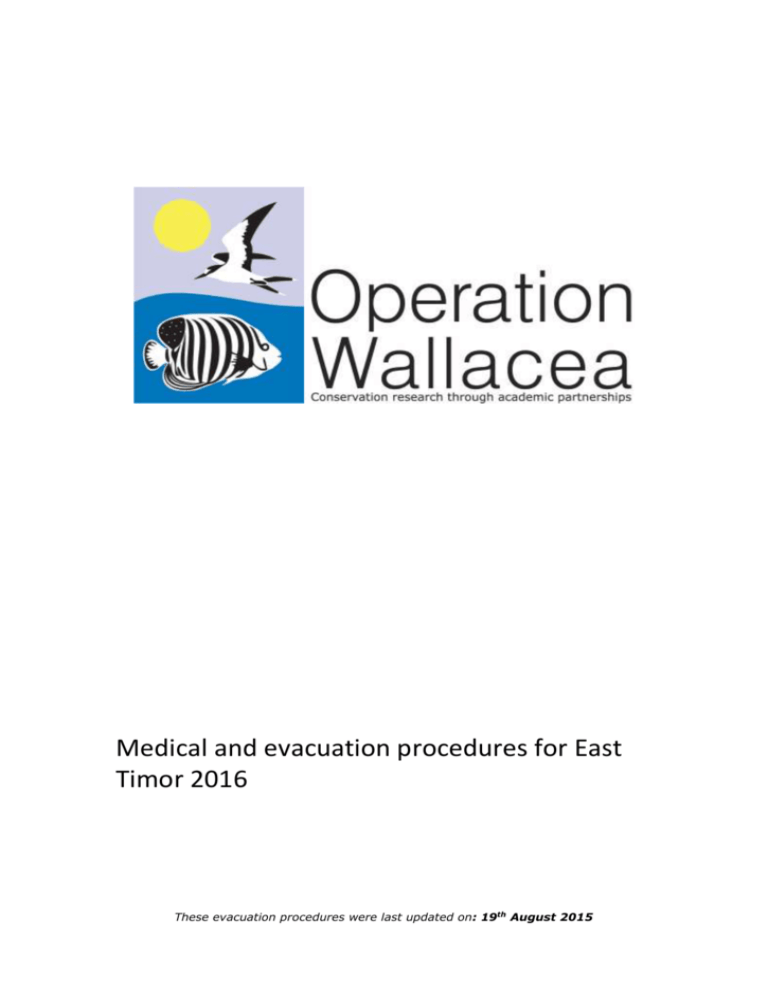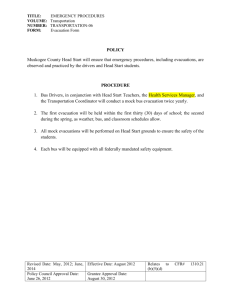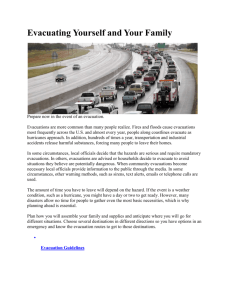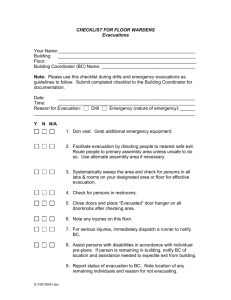Emergency evacuations
advertisement

Medical and evacuation procedures for East Timor 2016 These evacuation procedures were last updated on: 19th August 2015 Contents 1. Introduction ...................................................................................................... 3 Medical screening .............................................................................................. 3 Medical questionnaire ........................................................................... 3 PADI .................................................................................................................... 3 Screening ................................................................................................ 3 Roles in the event of an emergency .................................................................. 4 Medium Priority ..................................................................................... 4 High Priority ........................................................................................... 4 Emergency .............................................................................................. 4 2. Medical facilities in country ............................................................................... 5 Facilities in Dili ................................................................................................... 5 Facilities in Bali ................................................................................................... 6 Facilities in Darwin ............................................................................................. 6 3. Medical cover................................................................................................... 6 4. Evacuation from the forest sites ....................................................................... 6 Overview ............................................................................................................ 6 Medium and High priority evacuations ............................................................. 7 Emergency evacuations ..................................................................................... 7 Evacuation times from forest camps to Dili....................................................... 8 5. Evacuation from the marine sites ..................................................................... 8 Medium and High Priority evacuations ............................................................. 8 Emergency evacuations ..................................................................................... 9 6. Reporting and logging ...................................................................................... 9 7. Mass evacuations and disaster management .................................................... 9 Major incident with no prior warning.............................................................. 10 These evacuation procedures were last updated on: 19th August 2015 1. Introduction Medical screening All participants will be required to enter their medical details onto the Operation Wallacea data portal. Details of how to log on are sent out upon receiving the booking from the participant. The data is stored securely and is initially only available to certain Operation Wallacea staff members, and, for groups of school students, the teacher leading the group. Medical questionnaire All participants will be required to enter their medical details onto the Operation Wallacea data portal. Details of how to log on are sent out upon receiving the booking from the participant. The data is stored securely and is initially only available to certain Operation Wallacea staff members, and, for groups of school students, the teacher leading the group. PADI All expeditioners who wish to dive during the expedition will also be required to complete a PADI (Professional Association of Dive Instructors) medical questionnaire which must be returned to Operation Wallacea. Those volunteers who have answered ‘yes’ to any of the questions contained within the PADI medical questionaire are also required to seek further assessment from a suitably qualified clinician and will not be allowed to dive unless the declaration on the reverse side of the PADI form has been signed by the assessing clinician thereby acknowledging the expeditioner as being medically safe to dive. Screening All medical forms are assessed by Operation Wallacea. The country manager may seek to contact the participant to gather further information, which they would then enter on to the portal. Following the initial screening by the country manager, the details are then passed to the on-site medic. He or she can ask for further information, and will have an opportunity to discuss any issues of concern at a medical meeting (between the expedition medics and Operation Wallacea staff) held approximately 3 months prior to the expedition. The team of medics will discuss any potential medical issues, advise anyone if a further consultation with a medic is required and will also suggest additions to the medical kits in light of any pre-existing health problems highlighted. Insurance Operation Wallacea has purchased Medical and Repatriation insurance cover to a value of £1 million for all volunteers and staff. Following the medical meeting, the medical details of any participants who have described current or past health concerns, or are taking any current medication, will be passed on to Operation Wallacea’s insurers. They may then want to talk directly to the participant if they These evacuation procedures were last updated on: 19th August 2015 have any further questions, and in some cases may choose to request a premium payment in order to provide cover for any pre-existing conditions. Roles in the event of an emergency Carefully planned evacuation protocols are in place for both forest and marine sites in East Timor. These protocols are well understood by senior staff working on site in the event that a medical evacuation should be necessary. Due to the variable nature of potential injuries and other limiting factors (such as the availability of high level medical facilities) a number of different evacuation scenarios must be prepared for prior to the expedition commencing. All staff are fully briefed in these scenarios with this report describing the most likely evacuation options. Once a serious medical incident is identified the relevant Site Manager will take control as the Incident Coordinator coordinating the evacuation up until the point there has been a full hand-over of the patient to the East Timor Country Coordinator. The Medical Officer and Site Manager will decide the level of evacuation required for the patient in consultation with the East Timor Country Coordinator. Evacuations are to be classified as either Medium Priority, High Priority or Emergency. Medium Priority Cases in which the patient is in no immediate danger but on-site medical facilities are considered to be unable to cope with the patient’s existing condition and that without seeking outside medical attention the patient’s condition is likely to deteriorate. Such a scenario requires the patient to be moved as quickly as possible, usually without the need to hire special vehicles or boats (i.e. rely upon public transportation only) to the nearest appropriate medical facility. Typically a Medium Priority evacuation would see a patient evacuated to either Baucau or Dili. High Priority Cases where the patient’s health is at risk if immediate action is not taken. An example of this is a broken bone. This normally requires departure on a scheduled flight from Dili to either Darwin or Bali and may require the use of chartered vehicles if deemed necessary. Emergency Cases where the patients’ life is at risk if immediate action is not taken. This requires the fastest possible route and will almost certainly require the use of charter vehicles and boats and may also include the use of a chartered plane should it be considered necessary and possible. In all cases where a patient is being transferred to a medical facility they should be accompanied either by a site Medical Officer or someone considered appropriate to accompany the patient. The absence of a Medical Officer from the site whilst the These evacuation procedures were last updated on: 19th August 2015 patient is accompanied off-site may require the suspension of activities at the site until the Medical Officer has returned or alternative medical personnel cover exists. It is the responsibility of the senior Medical Officer at the relevant site in conjunction with the Site Manager to determine if an evacuation is required the level of the evacuation and to ensure the patient is stabilized and properly prepared prior to evacuation. The senior Medical Officer in conjunction with the East Timor Country Coordinator will discuss and agree as to the nature of the evacuation (destination, medical assistance being sought) as early as possible in the evacuation process. Operation Wallacea has purchased Medical and Evacuation Insurance cover for all expedition participants in the unlikely event that an evacuation from site should be required. Where an evacuation is deemed necessary, the East Timor country coordinator will be responsible for contacting the Opwall designated 24/7 Medical Assistance support line on +61 290202 8222 and informing them of the need for an evacuation including condition of the patient and planned route of evacuation. This evacuation will be along the evacuation routes that have been discussed and agreed with the Medical Assistance company (www.medicalassistance.com.au). The East Timor coordinator may be required to pass on specific medical information relevant to the patient to the assistance company as well as seek further medical opinion. Maintaining good lines of communication between the Site Medical Officer and Site Manager, the East Timor Country Coordinator and the medical assistance company is critical to ensuring a successful evacuation. All senior staff involved in a major accident or emergency procedure should keep detailed notes of times, actions taken, communications and costs incurred. After the incident has been closed it is the responsibility of the Site Medical Officer in conjunction with the Site Manager and East Timor Country Coordinator to compile a detailed report of the incident and medical procedures followed. 2. Medical facilities in country Facilities in Dili Dili has a small private clinic that will be used in medium priority evacuations. Stamford Medical Centre Rua Martires de Patria Mandarim Dili +6703311209 +6703310141 These evacuation procedures were last updated on: 19th August 2015 Facilities in Bali We use the Siloam Medical Group in Bali or Darwin for high priority evacuations, choosing the most appropriate hospital based on flight schedules to Bali and Darwin. Bali also has a number of decompression chambers and could be used as a secondary facility if we could not evacuate to Darwin. RSUP SANGLAH, Jl Diponegoro – Denpasar – Bali Emergency Phone: +62361226363 Switchboard Operator: +62 361 227911 – 227915 Fax +62 361 224206 or +62316 226363 a. +62818511318 (Dr Etty Herawati– Head of Hyperbaric Unit RSLP SANGLAH) b. +628124672923 (Dr Kadek Sosiawati) Hyperbaric Doctor c. +62361 227911 - 62 361 227915 (connects to Operator) d. +628124655281 (Peter Manz – Hyperbaric Health Representative) Facilities in Darwin These facilities can be used for evacuations from either of the forest or marine sites in East Timor. This is a top level hospital and can be used for high priority or emergency evacuations. Royal Darwin Hospital 87 Mitchell Street, Darwin, NT 0800 Phone: +61 (08) 89992400 3. Medical cover Up to two forest camps and one marine site will be operational in East Timor 2016 with a qualified medic to be based at each camp / site. Such medical staff will be practising professionals such as a doctor, paramedic, or nurse with accident and emergency experience. A medical kit is provided at each site, the content of which is determined prior to the expedition commencing in consultation with professional medics. These kits are designed to deal with as many non-emergency medical situations as is reasonably possible and to also support emergency incidents necessary for stabilization of a patient prior to transfer to a suitable medical facility. 4. Evacuation from the forest sites Overview These evacuation procedures were last updated on: 19th August 2015 On arrival in Dili the patient can be stabilised in the local hospital before transferring to better medical facilities located in Bali or Darwin if considered necessary. The main challenge with all forest evacuations is getting the patient out of the forest and to a vehicle. At each forest camp there is a team of staff who have the skills and equipment necessary to transport the patient to the nearest road access point to a waiting vehicle. Dili can be reached in 6 hours from the evacuation point of any forest camps. Medium and High priority evacuations Most Medium or High Priority evacuations will initially be evacuated to the Dili hospital for treatment and/or to be stabilised whilst ongoing travel arrangements to Darwin or Bali are organised if deemed necessary. The procedure is as follows: The responsible medical officer at the site will assess the patient and in conjunction with the Site Manager a decision will be made to evacuate the patient; The Site Manager will notify the East Timor Country Coordinator of the decision in order that he can contact the insurance company to inform them of the situation; The patient will be transported out of the forest, and then driven to Dili in the standby vehicle (6 hours). A medical officer would normally accompany the patient to Dili in all High Priority cases but designated staff members may be used for Medium Priority cases. The East Timor Country Coordinator will ensure that preparation for the patients arrival in Dili is undertaken and that accommodation as well as an appointment to see a doctor have been confirmed upon arrival of the patient; The East Timor Country Coordinator will contact Operation Wallacea’s UK office to inform them of the situation and the UK office will in turn liaise with the patient’s next of kin to inform them of developments; Onward travel to Bali/Darwin will be arranged using scheduled flights; there are several scheduled flights each day from Dili to Bali/Darwin. Emergency evacuations The medical officer on site will assess the patient and with the Site Manager make a decision to undertake an Emergency evacuation. The Site Manager will immediately notify the East Timor Country Coordinator of the situation. The East Timor Country Coordinator will contact the Mayday assistance to inform them of the situation and to decide upon the most appropriate mode of transportation and medical facility to which the patient should be transferred. Under certain critical conditions this may require the insurance company organising a chartered medi-vac flight from Dili. These evacuation procedures were last updated on: 19th August 2015 The patient will be transported out of the forest, and then driven to Dili in the standby vehicle (6 hours). A medical officer will accompany the patient initially to Dili and onwards until the patient is deemed to have received appropriate medical attention and care. The East Timor Country Coordinator will contact the UK office to inform them of the situation and the UK office will liaise with the patient’s next of kin to inform them of the situation. Regular updates of the patient’s condition will be relayed by the East Timor Country Coordinator to the UK office. Evacuation times from forest camps to Dili Expedition base: Approximately 6 hours by motor vehicle 5. Evacuation from the marine sites Overview Operation Wallacea’s marine sites in East Timor are located near to the town of Tutuala, from here it takes 6 hours to drive to Dili. Medium and High Priority evacuations Medium priority evacuations would normally be sent to Dili for treatment. The procedure would typically be as follows: The medical officer on site will assess the patient and following consultation with the Site Manager make a decision to evacuate the patient. The Site Manager will inform the East Timor Country Coordinator of the impending evacuation who will in turn inform the Opwall office. The East Timor Country Coordinator will ensure that preparation for the patient’s arrival in Dili is undertaken and that accommodation as well as an appointment to see a doctor have been confirmed upon arrival of the patient. Evacuations from Tutuala will be carried out with the standby vehicle, taking 6 hours to get to Dili. A medical officer would normally accompany the patient to Dili in all High Priority cases but designated staff members may be used for Medium Priority cases. The East Timor Country Coordinator will ensure that preparation for the patients arrival in Dili is undertaken and that accommodation as well as an appointment to see a doctor have been confirmed upon arrival of the patient; The East Timor Country Coordinator will contact Operation Wallacea’s UK office to inform them of the situation and the UK office will in turn liaise with the patient’s next of kin to inform them of developments; These evacuation procedures were last updated on: 19th August 2015 Onward travel to Bali/Darwin will be arranged using scheduled flights; there are several scheduled flights each day from Dili to Bali/Darwin. Emergency evacuations The medical officer on site will assess the patient and following consultation with the Site Manager make a decision to evacuate the patient. The Site Manager will inform the East Timor Country Coordinator of the impending evacuation who will in turn inform the Mayday Assistance and the UK office. Patients will be evacuated from Tutuala with the standby vehicle to Dili (6 hours). The medical officer will accompany the patient to the medical facilities in Bali or until the patient is able to receive expert medical attention. The Site Manager will discuss with the East Timor Country Coordinator and decide on the most appropriate mode of transportation and medical facility to which the patient should be transferred. Under certain critical conditions this may require the insurance company organising a chartered medi-vac flight from Dili. The East Timor Country Coordinator will contact the UK office to inform them of the situation enabling the UK office to liaise with the patient’s next of kin and inform them of the situation. Regular updates of the patient’s condition will be relayed by the East Timor Country Coordinator to the UK office. 6. Reporting and logging During evacuations it is crucial that a log is kept by both the Site Manager and the East Timor Country Coordinator detailing times, personnel involved and all other details relevant to the evacuation process. All medium priority evacuations must be logged by the Site Medical Officer and included in the post-season medical report. For High Priority and Emergency level evacuations the Site Medical Officer, relevant Site Manager, and East Timor Country Coordinator must each make a detailed report immediately following the incident. A full safety assessment must be carried out after all evacuations and if a similar incident is likely all activities must be stopped until the situation has been rectified. The East Timor Country Coordinator will collate the reports of all High Priority and Emergency evacuations for submission to Operation Wallacea. They will also submit relevant medical documentation and a summary of evacuation costs to the Opwall office to enable a claim to be processed. 7. Mass evacuations and disaster management These evacuation procedures were last updated on: 19th August 2015 There is the possibility, albeit incredibly small, that a large scale incident could occur which would require a large number of Operation Wallacea volunteers and staff being repatriated. Such incidents could include political unrest, natural disaster and terrorist attacks. These incidents can be broken into two types, those with prior warning and those without. Major incident with prior warning Some major incidents come with a degree of prior warning. A good example of this is political unrest resulting in violence, which would have a build up period. We constantly monitor the political situation of the area we work in and if our experienced field operatives decide that the political situation has become unsafe they would order a full evacuation. In such an incident the East Timor Country Coordinator would liaise with the Opwall Office and relevant embassies to agree the best route for repatriation. Major incident with no prior warning Some incidents, such as a terrorist attack or natural disaster, would have no prior warning. In cases such as these the field staff would get all volunteers and staff to a place they deemed safe by which ever means they decide best. From here the East Timor Country Coordinator would contact the volunteers’ embassies to coordinate an evacuation strategy. The details of such an evacuation would vary dramatically depending on the situation and as such it is impossible to produce more detailed information. These evacuation procedures were last updated on: 19th August 2015





